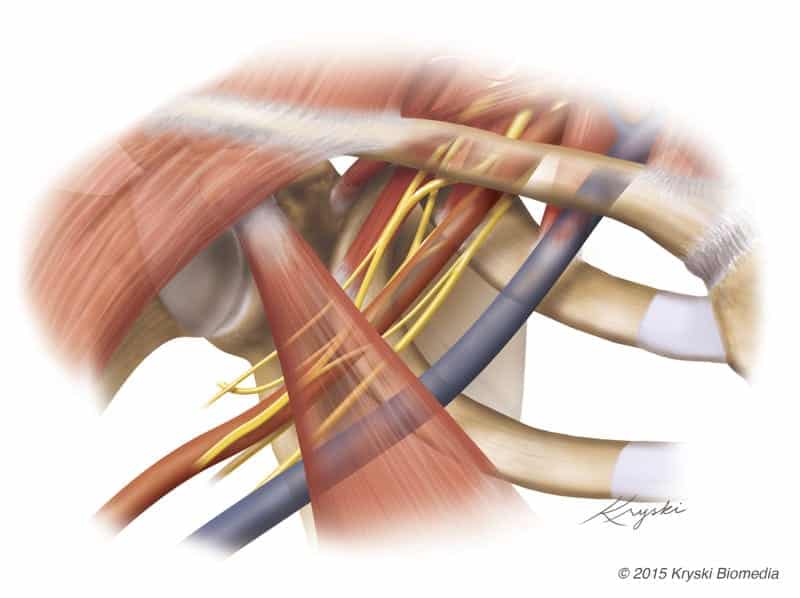Introduction
Why do you need an imaging test for thoracic outlet syndrome (TOS) to assess soft tissues and rule out differential diagnoses like spinal cord issues? Curious about how this diagnostic tool can provide crucial insights into your health? Imaging tests play a vital role in identifying TOS, guiding treatment decisions, and ensuring accurate diagnosis of soft tissues for doctors and differential diagnoses.
Table of Contents
Table of Contents
SB Nation
Thoracic outlet syndrome is a rare but serious injury that a few major league pitchers have suffered in recent years. How has this injury impacted the effectiveness of pitchers, both before diagnosis and after surgery?
Last week, I wrote about Jaime Garcia’s surprising comeback from several arm injuries, including thoracic outlet syndrome, which is one of the rarest and most difficult injuries for a pitcher to come back from. This week, I thought I’d explore this injury in more detail by examining the effects it can have on a pitcher’s effectiveness, both before diagnosis and after surgery.
Thoracic outlet syndrome is an injury that involves the compression of blood vessels and nerves that extend from the neck to the shoulder. It can result in continued pain and numbness in the shoulder and throughout the arm, and it is often difficult to diagnose. The most common surgical procedure for this injury involves the removal of an upper rib near the shoulder. This operation lessens the pressure on the nerve bundle by giving it a wider area to pass. If you want to know more about the injury itself, I would highly recommend reading a piece by Corey Dawkins and Ben Lindbergh on Baseball Prospectus (you will need to search from the home page), titled, ‘Collateral Damage: Rounding Up the Usual Suspects: Thoracic Outlet Syndrome.’ The article covers many aspects of the injury that I couldn’t possible explain. The ending of their piece was ominous but telling about the nature of the injury:
“The prognosis for almost all of the injuries we have discussed in previous installments called for a good-to-excellent chance that the afflicted player would return to his previous levels. However, thoracic outlet syndrome still possesses the potential to be career-ending (or worse).”
Given the rarity of this injury and the lack of research surrounding it (as far as I know), I thought I’d take a look at PITCHf/x data of pitchers who have suffered this injury to see how the injury impacted their performance, both before and after diagnosis/surgery.
Beckett dealt with multiple injuries in the last couple years of his career, one of them being thoracic outlet syndrome. In 2013, he made eight starts before going on the disabled list with a groin strain. Apparently, he first began experiencing the symptoms of thoracic outlet syndrome when he was already on the disabled list. After an unsuccessful attempt to rehab without surgery, he underwent surgery in July, ending his 2013 season. He made 20 starts in 2014 before once again having his season cut short, this time due to a hip injury. Beckett announced his retirement after the 2014 season.
Carpenter’s career was effectively ended as a result of this injury, which was one of many arm injuries he dealt with throughout his excellent career. After giving the Cardinals everything he had in 2011, including starting Game 7 of the World Series on three days rest, Carpenter missed almost all of 2012 due to thoracic outlet syndrome. Like Beckett, Carpenter opted for surgery only after an unsuccessful rehab attempt. Initially, it was reported that Carpenter would miss six months due to the injury, but remarkably, he returned in late September despite having the surgery in early July.
He ended up pitching just 17 innings in the regular season and 13 2/3 in the postseason that year, and it was very clear that Carpenter was not anywhere near the same pitcher that he was just a year earlier. According to Brooks Baseball, all of his pitches had lost significant velocity from 2011 to 2012.
In addition, Carpenter’s Zone% in 2012 was 39.9 percent, significantly lower than his career rate of 51.3 percent. While it’s hard to conclude much from such a small number of innings, pitch velocities and zone rates tend to stabilize relatively quickly, and they do seem to say a lot about where Carpenter was at in that point of his career. His other numbers weren’t great either, as his walks were up and his strikeouts were down, giving him an xFIP near five in his 31 2/3 innings.
Carpenter’s symptoms reappeared in spring training the next year, and he would never pitch again at the major league level, retiring after the 2013 season. While there isn’t a lot of data on Carpenter post-surgery, the little that exists says a lot on what this injury can potentially do to a pitcher. Carpenter got a brief look at a pitcher’s nightmare scenario: low velocity, terrible command, and inconsistent results, not to mention pain that could impact him for the rest of his life.
Marcum dealt with thoracic outlet syndrome during the 2013 season, eventually having surgery in July of that year. After signing a minor league deal with Cleveland for 2014, he was shut down again due to recurring issues in his shoulder and didn’t appear in the majors all year. He has pitched 35 innings this season for the Indians but was recently outrighted to AAA. Like Carpenter, Marcum has seen his effectiveness diminished as a result of this injury. While Marcum was never known for throwing hard, his average fastball velocity was down to 86 MPH in 2013 just prior to his diagnosis, and it has been at the same level so far in 2015.
Marcum also appears to have struggled with his command, as his walk rate (7.8 percent) is up slightly and his Zone% is a very low 40.9 percent. In addition, he has given up nine home runs in his 35 innings so far in 2015, likely due to a combination of bad command in the zone and diminished velocity. While Marcum is only 33, he doesn’t appear to be more than a replacement level pitcher at this point, meaning that his career could be nearing its end.
Harrison has had thoracic outlet syndrome twice–once in each shoulder. Interestingly, he had the first surgery on his throwing shoulder in 2009 and was able to return and pitch effectively for a few years. He had a rough year (63 1/3 innings) in 2009 pre-surgery and struggled throughout 2010 as well. While his fastball velocity wasn’t particularly low during these two seasons, it did increase a couple ticks as he became further removed from surgery, eventually peaking at 93.9 MPH in 2011.
Harrison also improved his command as he became further removed from his surgery. His strikeout and walk rates were significantly better in 2011, and he gave up considerably less hard contact (including fewer home runs) that year.
| Season | IP | K% | BB% | HR/FB | Soft% | Hard% |
| 2009 | 63.1 | 12.0 % | 8.1 % | 13.2% | 15.6% | 28.1% |
| 2010 | 78.1 | 12.9 % | 11.0 % | 11.6% | 16.4% | 27.1% |
| 2011 | 185.2 | 16.3 % | 7.4 % | 7.1% | 26.5% | 20.1% |
Harrison appears to be the exception on this list, as his best seasons came after his thoracic outlet surgery. His age was certainly a factor, as he was just 24 at the time of his injury. Even so, it took him a season and a half to recover fully and pitch effectively for the Rangers, and this success only lasted two years, before Harrison went down with another series of injuries.
* * *
There are certainly other pitchers not included in this article who dealt with thoracic outlet syndrome before the PITCHf/x era. In addition, there are pitchers like Noah Lowry, who never threw a major league pitch after thoracic outlet surgery, despite only being in his late 20s at the time. While there may not be enough data to say anything definitive about pitchers recovering from this injury, there are a few possible trends worth noting.
The injury has the potential to seriously hurt a pitcher’s velocity, although this hasn’t been the case in all situations. While pitchers like Chris Carpenter and Shaun Marcum saw a noticeable drop in their velocity, Matt Harrison saw his velocity increase as he became further removed from the surgery.
The biggest area these pitchers seemed to struggle was with their command, both in and out of the strike zone. This manifested itself in slightly higher walk rates, a lower percentage of pitches in the strike zone, and hard contact on pitchers that were in the strike zone, including abnormally high home run rates.
There aren’t a lot of pitchers who have had this injury, but the track record isn’t good. Counting on a pitcher who has been through this injury is a terrifying proposition, especially considering the fact that the pitchers in this article are some of the most injury-prone players in recent memory. Perhaps Jaime Garcia can break the trend and give hope to pitchers who suffer this injury in the future. His success in seven starts this year defies some of the trends shown by the other pitchers with this injury. Still, until we have a better track record of pitchers returning from thoracic outlet syndrome, it will keep its reputation as one of the worst arm injuries that a pitcher could suffer.
. . .
Nick Lampe is a contributor at Beyond the Box Score and Viva el Birdos. You can follow him on Twitter at @NickLampe1.

















Hello! I got a first rib surgery on my right side in 2020 for TOS Venus when I was living in Australia. I just moved back to Oceanside, CA and I have had symptoms of neurogenic TOS on my left side. I have seen doctors and gotten an MRI done and it didn’t show anything and I want another opinion because I’m pretty sure I have it. My left scalene muscle hurts and if I push on it there is painful radiation down my left arm and I have a lot of left neck pain as well. I do get tingles in my left pinky and ring finger as well. I would love to chat with any specialists you may know that knows this condition really well. They are really hard to find where I live and any help would be amazing.
Hi, Joey-
We are absolutely glad to help you find TOS specialists. Contact us here: https://www.tosmri.com/thoracic-outlet-syndrome-education/contact-us/